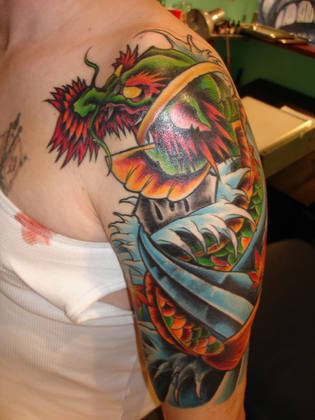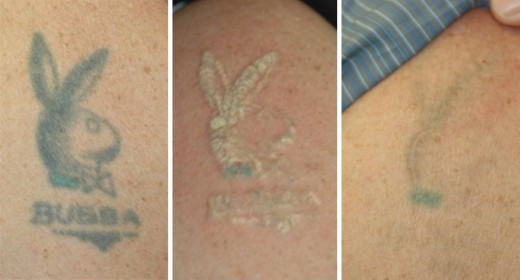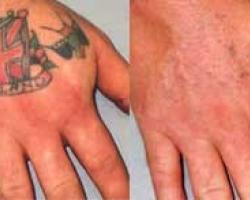Tattoo Removal Methods and Side-Effects - Laser Tattoo Removal Surgery and Clinics

The process of getting a tattoo involves injecting ink into the skin using a series of needles. Whereas a tattoo was once seen as permanent, there are now a range of tattoo removal methods available.
What were the previously available methods?
Past tattoo removal methods included dermabrasion, a painful technique in which the upper layers of the skin, or epidermis, are scrubbed away. This usually left the skin in a raw state, and would take weeks to heal over. There is also the possibility of a scar forming. Dermabrasion requires a local anaesthetic but remains popular because of its cost-effectiveness and good results. Other tattoo removal techniques include excision, which means removal by cutting. While this method is used largely for the removal of organs and tumours, it can also be used for tattoos and involves cutting away the sections of skin which have been injected with ink. This method is still used today for larger tattoos, in combination with a skin graft.

Do you have a tattoo that you wish to remove?
What's available now?
Present tattoo removal methods include the manual or mechanical. It involves the application of a specialised gel, usually mixed with salt water. This is tattooed into the skin and is intended to bond the ink to the gel and therefore be (leaked) out of the skin. However, this practice is unpredictable and may very well result in scarring, changes in tissue texture, keloids (scars composed of collagen), and further discolouration of the skin. Intense pulsed light therapy is a new technology which uses high-intensity light. With intense pulsed light therapy, a gel is applied to the skin and a wand is waved over it. While this method is supposed to be less painful than laser treatments, it's also far more expensive.
Laser Tattoo Removal Surgery
One of the most popular tattoo removal methods used today utilises a laser. Typically, Q-switched lasers are used, which produce a higher power than continuous-wave lasers which were used in the past.
In laser tattoo removal, the lasers react with the tattoo ink in order to break it down. This occurs when the light from the laser heats up the ink molecule and forces it to split into smaller fragments, which can then be removed with normal body processes. Once the ink is disintegrated it is absorbed by the body in order to create a fading effect. This, of course, means that repeated visits to your laser specialist are required. As with any tattoo removal method, there is a possibility of scarring, especially on areas of thinner skin.
Laser tattoo removal treatment sessions are generally spaced around 6 weeks apart. The number of sessions it may take to completely removed are dependent on the individual and other factors including skin tone, location of the tattoo, colour of the tattoo, the amount of ink used and the health of the individual. A healthy patient will get much better results from laser treatment because the method utilises one's own immune system and regular functions.
Depending on your tattoo you may very well need up to 10 sessions of laser removal, which can end up costing anywhere up to $900 a session. Large, colourful tattoos could cost thousands to remove.
What About the Pain?
While all tattoo removal techniques usually involve amounts of pain higher than getting the tattoo in the first place, laser tattoo removal can sometimes exceed the pain threshold of the individual. In this case, strong topical and injected anaesthetics are used.

Tattoo Removal Clinics
- Laser Tattoo removal: Find tattoo removal clinics in Melbourne
Locate a Laser Tattoo removal specialist in Melbourne. Get the lowdown on how to get rid of unwanted tattoos incl traumatic tattoos. - Loading...
Lasertech Clinic - Adelaide is your Premier Laser Clinic for skin rejuvenation, hair removal, tattoo removal, and day spa - Hair Removal - Sun Damaged Skin - Tattoo Removal - Pigmentation Melbourne
Instant Laser Clinic Melbourne specialise in - hair removal melbourne, pigmentation melbourne, sun damaged skin melbourne, tattoo removal melbourne, cosmetic laser melbourne, laser therapy melbourne, hair treatment melbourne, permanent hair reduction
Side Effects and Consequences of Tattoo Removal
After laser treatment has occurred, the skin will be raised and discoloured, while some individuals may even bleed. A scab will usually form over the treated tattoo but usually disintegrated within two weeks. Antibiotic ointments are usually applied to the affected area in between laser treatments.
Side effects of laser treatment for tattoo removal include an alteration in the pigment of the skin, as well as the texture. Hypopigmentation involves the occurrence of white spots on dark skin, whereas hyperpigmentation or dark spots are more common in fair skin. Other side effects of concern include the breaking down of ink pigment into toxic molecules that may migrate to vital organs such as the liver or kidneys.
In Summary:
Unfortunately there exists no “optimal” method of tattoo removal that is either pain- or scar-free. All techniques carry with them different side-effects and drawbacks. When choosing a method with which to remove your tattoo you will need to consider factors such as cost, time and results.



